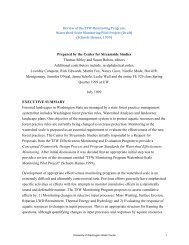Copyright 2012 Aileen M. Echiverri-Cohen - University of Washington
Copyright 2012 Aileen M. Echiverri-Cohen - University of Washington
Copyright 2012 Aileen M. Echiverri-Cohen - University of Washington
Create successful ePaper yourself
Turn your PDF publications into a flip-book with our unique Google optimized e-Paper software.
demonstrated appropriate skewness given the expected skewed nature <strong>of</strong> the U-shaped curve <strong>of</strong><br />
the AB effect. In contrast, PPI showed significant positive skewness and was corrected using<br />
natural log transformations, consistent with other PPI studies (Ornitz et al., 1989). To reduce<br />
outlier status, univariate and multivariate outliers were examined separately at pre- and post-<br />
treatment to isolate the correlated observations that <strong>of</strong>ten result in consecutive measurements in<br />
longitudinal studies (Tasca & Gallop, 2009). Univariate outliers were evaluated by running<br />
scatterplots <strong>of</strong> standardized residuals <strong>of</strong> measures, in addition to the inspection <strong>of</strong> z-scores where<br />
cases with standardized residual values exceeding 3.29 in absolute value were identified as<br />
potential outliers (Tabachnick & Fidell, 2001). The outliers for the repeated measures, were<br />
determined by getting the absolute value <strong>of</strong> the correlation <strong>of</strong> the observed values and the<br />
subject-specific predicted values. The lower 5 th percentile <strong>of</strong> the correlation coefficients were<br />
linked back to the subjects corresponding to potential multivariate outliers. Where there were<br />
potential outliers, variable transformation or changing scores on the variable for the outlier so<br />
that it is less deviant, were considered to minimize variability within groups (Tabachnick &<br />
Fidell, 2001). Missing data was addressed using restricted maximum likelihood (REML) within a<br />
random effects modeling and mixed model regressions analytic approach assuming that the<br />
missing data is independent <strong>of</strong> outcome variables (Gallop & Tasca, 2009).<br />
Evaluating Possible Covariates<br />
A bivariate correlation matrix was conducted across all variables to evaluate possible<br />
covariates. Covariates were included in the analysis if it was theoretically correlated with the<br />
outcome variables (Tabachnick et al., 2001). Age and education are demographic variables<br />
known to be related to executive functioning (Hasher & Zacks, 1988; Posner & Snyder, 1975;<br />
28
















